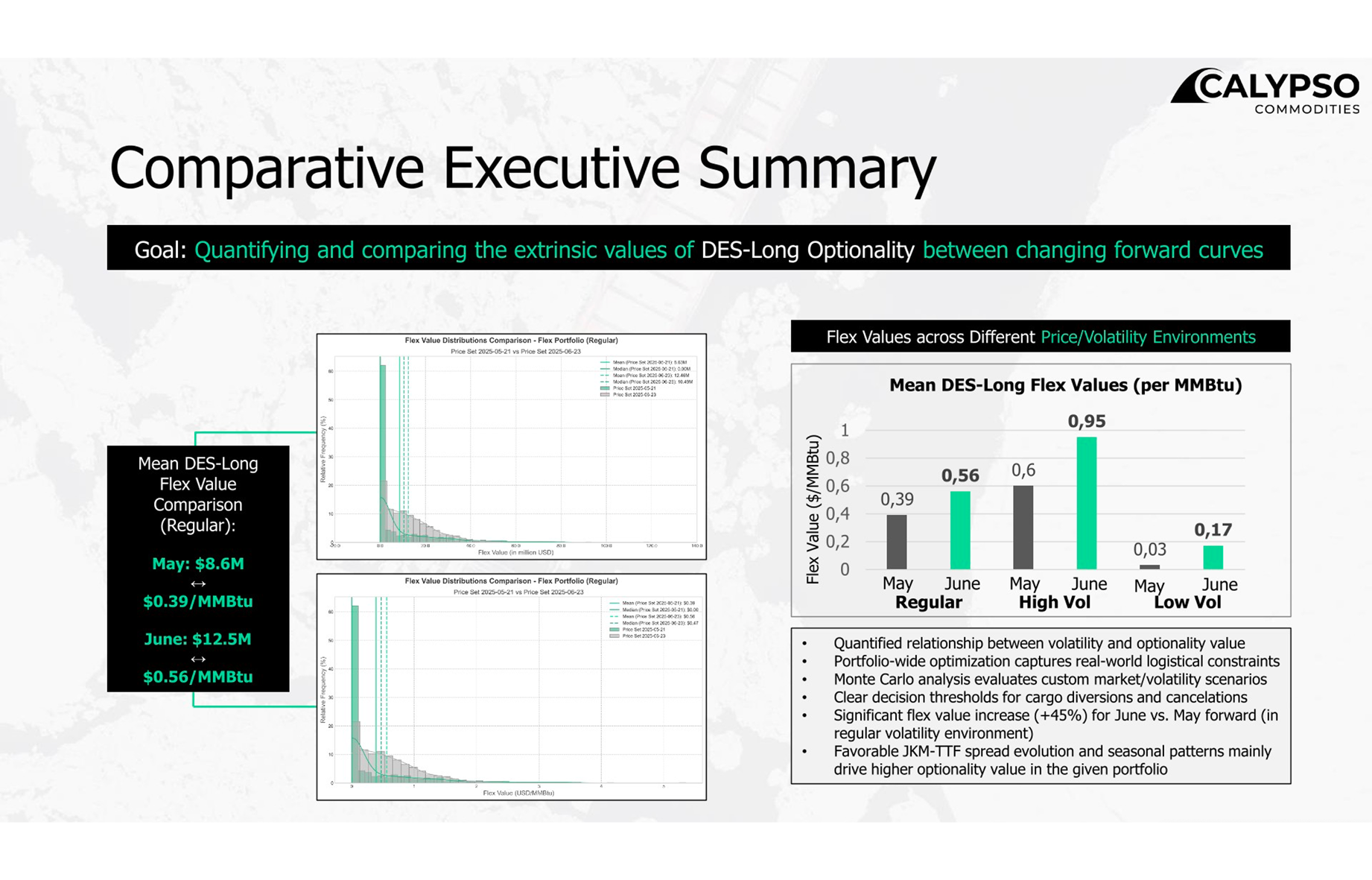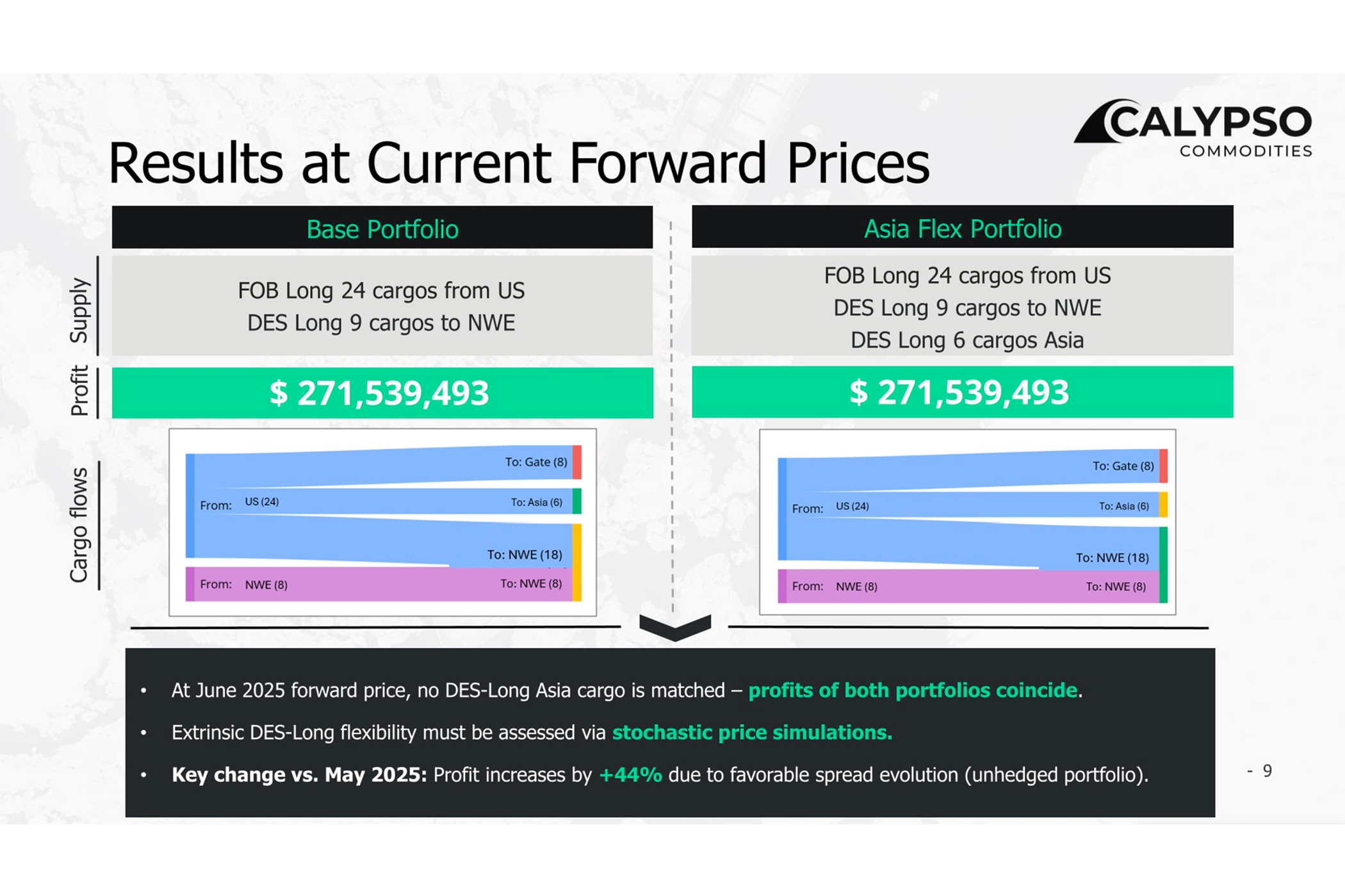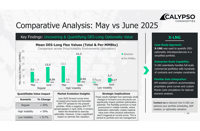Market-Driven Changes in DES Long Flexibility Value: Comparative Analysis and Implications for Portfolio Management
Check out the full detailed analysis here
What this update covers
- Objective: Re‑run the May 2025 DES‑Long study with June 2025 market inputs to quantify the month‑over‑month change in optionality value and exercise likelihood.
- Portfolios:
- Base Portfolio: Standard FOB Long‑US to DES Short‑Asia flows (no flex)
- Asia Flex Portfolio: Base + optional DES‑Long Asia capability
- Method: Hundreds of Monte Carlo price paths for HH, JKM, and TTF; full portfolio re‑optimization on each path; results segmented by regular, high‑vol, and low‑vol regimes.
- Comparative layer: Direct delta versus the May environment—updated decision boundary and flex valuation under June forwards and volatility.
What changed since May
- Forward curves and levels: June HH/JKM/TTF levels shift relative netbacks, affecting whether Asian diversion improves economics.
- Asia–Europe spread dynamics: The JKM–TTF relationship moves the “exercise boundary” for DES‑Long; the boundary is recalculated and compared to May.
- Seasonality effects: Different monthly demand/price shapes alter which delivery windows are more likely to exercise the DES‑Long option.
- Volatility profile: Re‑tested under the June vol backdrop to show how extrinsic value expands or compresses with changed uncertainty.
- Portfolio routing: Re‑optimization highlights where vessel allocation and alternative contract matches adapt under June conditions.


Key insights for decision‑makers
- DES‑Long value is sensitive to both spreads and absolute price levels: It increases when JKM’s advantage over TTF (net of logistics) expands, and compresses when that advantage narrows.
- The exercise map moved: The JKM–TTF decision boundary shifts under June curves, updating the thresholds at which Asian DES‑Long becomes favorable.
- Timing matters: Seasonality in June alters which months are more/less likely to exercise; use these windows to refine hedging, nominations, and scheduling.
- Core mechanics are unchanged: Value still comes from portfolio‑wide re‑routing, improved long–short matching, and better vessel utilization rather than isolated deal economics.
Who benefits from the update
- Traders: Align hedge triggers and diversion decisions with the updated JKM–TTF exercise boundary.
- Origination/Structuring: Calibrate pricing and terms for DES‑Long optionality using June‑based deltas versus May.
- Portfolio & Risk teams: Refresh stress tests and value‑at‑risk style views under the new curve and volatility environment.
- Shipping/Scheduling: Adjust fleet plans and route preferences to the revised exercise likelihood by month.

.svg)
Legal Notice
Impressum
Angaben gemäß § 5 TMG
Calypso Ventures GmbH
Bismarckstraße 10/12
10625 Berlin
Handelsregister: HRB 239736 B
Amtsgericht Charlottenburg
Umsatzsteuer: DE342781749
Vertreten durch:
Michael Schach
Kontakt
Telefon: +49 30 41734423
E-Mail: [email protected]
Nutzungsvereinbarungen
Imprint
Disclosures according to German law § 5 TMG
Calypso Ventures GmbH
Bismarckstraße 10/12
10625 Berlin
Registered number: HRB 239736 B
Amtsgericht Charlottenburg (Germany)
VAT: DE342781749
Represented by:
Michael Schach
Contact
Phone: +49 30 41734423
E-Mail: [email protected]
User Agreements
Market-Driven Changes in DES Long Flexibility Value: Comparative Analysis and Implications for Portfolio Management

Check out the full detailed analysis here
What this update covers
- Objective: Re‑run the May 2025 DES‑Long study with June 2025 market inputs to quantify the month‑over‑month change in optionality value and exercise likelihood.
- Portfolios:
- Base Portfolio: Standard FOB Long‑US to DES Short‑Asia flows (no flex)
- Asia Flex Portfolio: Base + optional DES‑Long Asia capability
- Method: Hundreds of Monte Carlo price paths for HH, JKM, and TTF; full portfolio re‑optimization on each path; results segmented by regular, high‑vol, and low‑vol regimes.
- Comparative layer: Direct delta versus the May environment—updated decision boundary and flex valuation under June forwards and volatility.
What changed since May
- Forward curves and levels: June HH/JKM/TTF levels shift relative netbacks, affecting whether Asian diversion improves economics.
- Asia–Europe spread dynamics: The JKM–TTF relationship moves the “exercise boundary” for DES‑Long; the boundary is recalculated and compared to May.
- Seasonality effects: Different monthly demand/price shapes alter which delivery windows are more likely to exercise the DES‑Long option.
- Volatility profile: Re‑tested under the June vol backdrop to show how extrinsic value expands or compresses with changed uncertainty.
- Portfolio routing: Re‑optimization highlights where vessel allocation and alternative contract matches adapt under June conditions.

Key insights for decision‑makers
- DES‑Long value is sensitive to both spreads and absolute price levels: It increases when JKM’s advantage over TTF (net of logistics) expands, and compresses when that advantage narrows.
- The exercise map moved: The JKM–TTF decision boundary shifts under June curves, updating the thresholds at which Asian DES‑Long becomes favorable.
- Timing matters: Seasonality in June alters which months are more/less likely to exercise; use these windows to refine hedging, nominations, and scheduling.
- Core mechanics are unchanged: Value still comes from portfolio‑wide re‑routing, improved long–short matching, and better vessel utilization rather than isolated deal economics.

Who benefits from the update
- Traders: Align hedge triggers and diversion decisions with the updated JKM–TTF exercise boundary.
- Origination/Structuring: Calibrate pricing and terms for DES‑Long optionality using June‑based deltas versus May.
- Portfolio & Risk teams: Refresh stress tests and value‑at‑risk style views under the new curve and volatility environment.
- Shipping/Scheduling: Adjust fleet plans and route preferences to the revised exercise likelihood by month.

.svg)
Legal Notice
Impressum
Angaben gemäß § 5 TMG
Calypso Ventures GmbH
Bismarckstraße 10/12
10625 Berlin
Handelsregister: HRB 239736 B
Amtsgericht Charlottenburg
Umsatzsteuer: DE342781749
Vertreten durch:
Michael Schach
Kontakt
Telefon: +49 30 41734423
E-Mail: [email protected]
Nutzungsvereinbarungen
Imprint
Disclosures according to German law § 5 TMG
Calypso Ventures GmbH
Bismarckstraße 10/12
10625 Berlin
Registered number: HRB 239736 B
Amtsgericht Charlottenburg (Germany)
VAT: DE342781749
Represented by:
Michael Schach
Contact
Phone: +49 30 41734423
E-Mail: [email protected]


.svg)
